Please click here to access the main AHDB website and other sectors.
- Home
- Knowledge library
- New plant growth regulators for use on pot- and pack-grown bedding plants
New plant growth regulators for use on pot- and pack-grown bedding plants
A number of plant growth regulators (PGRs) have recently become available for use on bedding plants and this, combined with recent label changes on existing products, have impacted the options available to control the growth of bedding plant crops.
While a range of cultural methods (such as temperature manipulation and management of the nutrient supply) are often used as primary growth control options, PGRs are used to help shape plants in the early stages of production, to hold mature crops prior to marketing, and to achieve often challenging customer specifications regardless of environmental growing conditions. To reflect commercial practice, the new and existing PGRs were applied in a range of water volumes and at different timings in trials to examine their performance.
Bedding and Pot Plant Centre research
Research was undertaken within the Bedding and Pot Plant Centre (BPPC) work programme to evaluate the efficacy and crop safety of a range of PGRs on bedding plants applied at cotyledon and pre- and post-transplant stages. The range of PGRs initially included in the trials was selected from promising products which had been trialled overseas or had recently received approval for use on related crops in the UK, and was subsequently expanded to include the new adjuvant, Stena. The various products examined are summarised below.
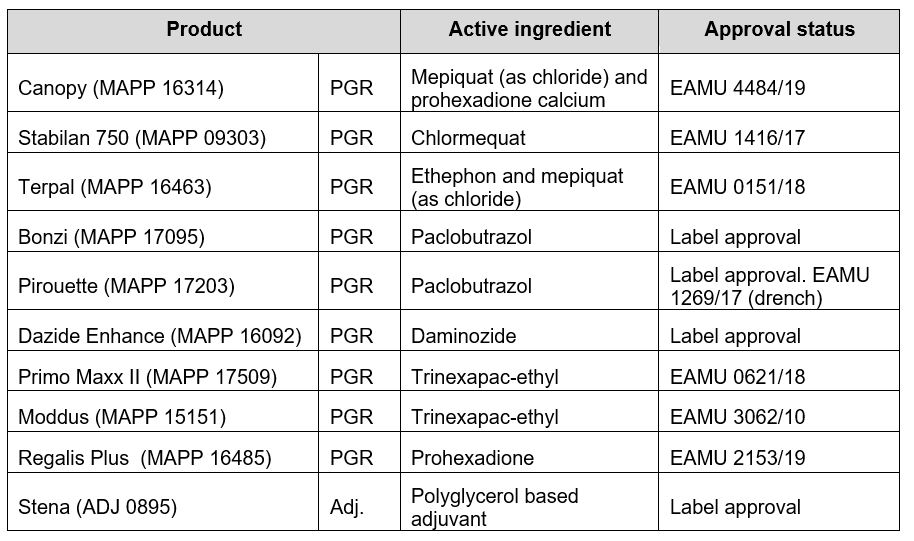
PGR application considerations
Application method: The three application methods used in the BPPC trials were: spray (300 L/ha of water); ‘sprench’ (5% cell / pot volume, often interpreted as a high volume spray) and drench (10% cell / pot volume). Products were used at a concentration equivalent to a spray at 300 L/ha water for all application methods. Sprays are obviously quicker and easier to apply than ‘sprenches’ or drenches, but less persistent in their effect.
Drench dose rates: Pirouette is effective when applied as a spray or drench. However, it does exhibit strong root uptake, therefore care should be taken when determining ‘sprench’ and drench dose rates. Similarly, newer products such as Terpal, Primo Maxx II, Canopy and Moddus can have a strong effect when applied as a drench, and applications were generally more successful at lower dose rates below those indicated on product labels / EAMUs.
Adjuvant addition: The adjuvant Stena increases PGR uptake, allowing the application rate of Terpal and Stabilan 750 to be reduced by 40-50%. Stena is reported by the manufacturer, SurfaPlus, to be effective with daminozide products too (such as Dazide Enhance). It should be noted however, that Stena would not have a similar effect if tank mixed with Bonzi.
New products and application rates should be tested on a small number of plants prior to wide-scale use. Products applied under EAMU approval are at the grower’s own risk.
PGR application at cotyledon stage
PGR application early in production, either at the cotyledon stage or just prior to transplant, can reduce the quantity of PGR required, while increasing application efficiency. For the trial, PGRs were applied as drenches (10% of tray volume) at a concentration equivalent to a spray in 300 L/ha water.
Effective with no follow up treatment: A number of PGRs treatments applied at the cotyledon stage produced marketable plants with no follow up treatment in production (see below). The Primo Maxx II dose rate may need adjustment for use on Dianthus and French Marigold as the plants were below specification.
Treatments with potential: Moddus (0.5 ml/L), Regalis Plus (2.08 g/L) and Terpal (3.33 ml/L) did not adequately control plant height in Cosmos, but efficacy could be improved by increasing the dose rate for these products.
Not effective: Dazide Enhance was not effective on Dianthus or Cosmos when applied at the label rate (6 g/L).
Not recommended: Primo Maxx II caused petal bleach on Cosmos; Terpal caused white spots on Dianthus petals.
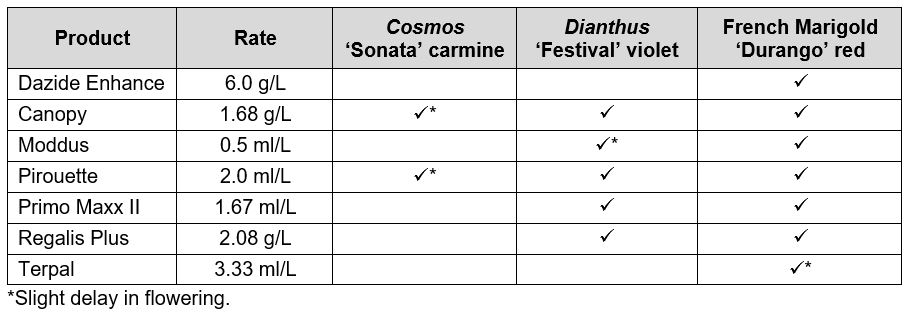
Effective pre- and post-transplant PGR programmes
A number of PGRs, applied either alone or in combination, pre- and post-transplant, provided effective growth control of the species included in this trial. Applications were made two days pre-transplant, and then seven days post-transplant, with a third application 10 days post-transplant if required.
Cosmos ‘Sonata’ carmine
High dose rates are needed to control the growth of Cosmos, as this is a vigorous species. Pirouette would be the preferred product as growers are likely to have more experience in its use, although other products were equally effective. Primo Maxx II is not recommended on Cosmos as it caused slight petal bleach at 2.0 L/ha.
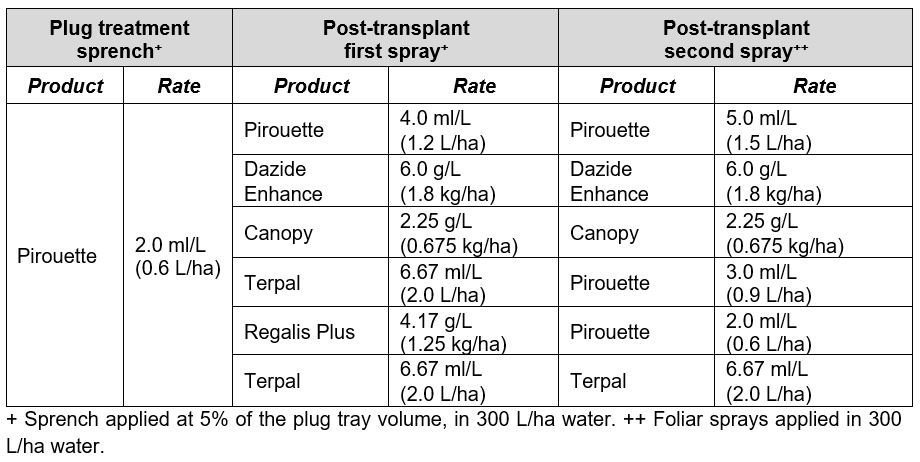
Dianthus ‘Festival’ violet
Both Pirouette and Terpal are effective and no crop damage occurred in any of the treatments outlined in the table below.
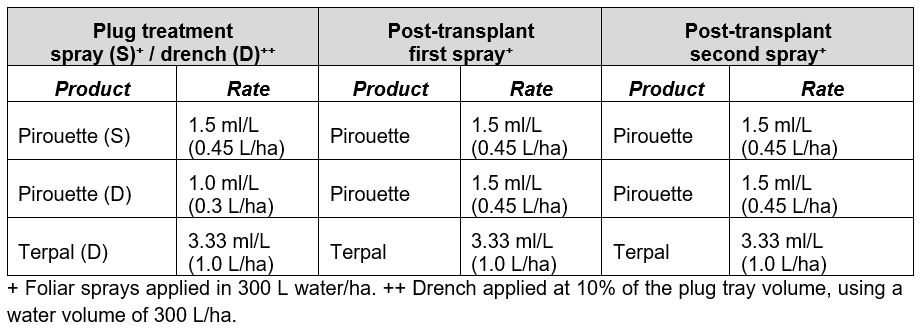
Pelargonium ‘Horizon’ red
Only one post-transplant treatment was required for Pelargonium. Terpal proved effective and produced good quality plants. Moddus was found effective when applied as a drench at plug stage (0.5 ml/L) followed by Terpal (1.67 ml/L) + Stena (2.5 ml/L), but the foliage was pale, with poor zoning.
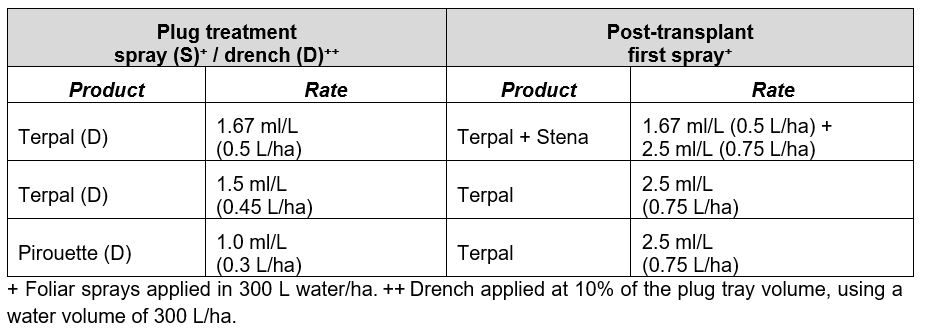
Osteospermum ‘Akila’ purple
The PGR programmes for Osteospermum were effective, but rates were slightly high, particularly in the Terpal programme. However, this trial took place slightly late and the results should be interpreted in the context of a late season crop produced under lower light levels and shortening days.
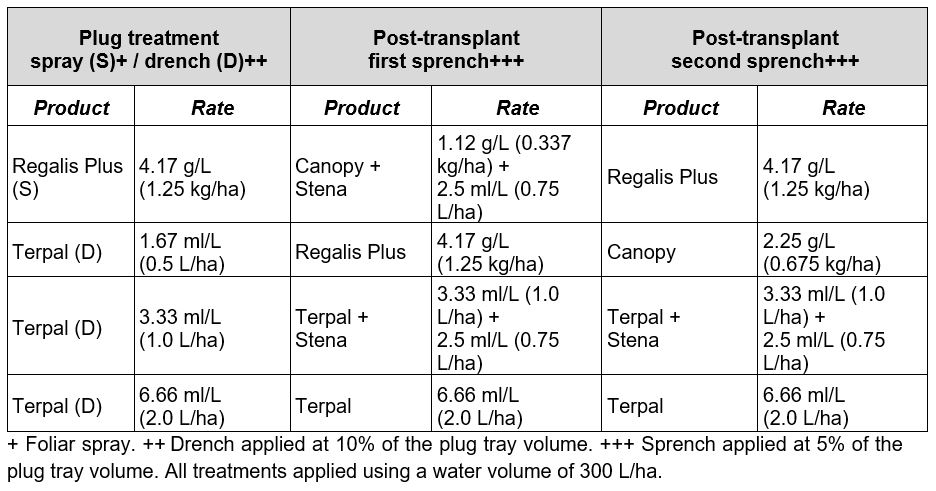
Guidance for grower trialling and use
Terpal appeared to perform well in many of the trials and is a product which should be tested in small-scale trials on nurseries to identify suitable rates and timings of application. Regalis Plus and Canopy may also have certain uses in commercial production, but along with Moddus and Primo Maxx II, should be used with care as all these products can lead to petal colour bleach when used around or after transplant.
Stena showed potential, reducing the rates required with Terpal and Stabilan 750. Commercial use of this adjuvant will be determined by the relative cost of it versus the savings made from reducing the rate of the PGR used.
As a result of the loss of drench application from the Bonzi label, Pirouette was examined as an alternative. Both products contain 4 g/L active ingredient and are the same formulation, so this is a simple ‘like-for-like’ change in terms of high volume-drench application.
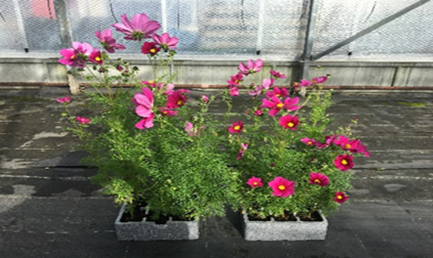
Cosmos (left to right): (a). water, (b). Pirouette plug sprench 0.6 L/ha and Pirouette 0.75 L/ha (x2) post-transplant.
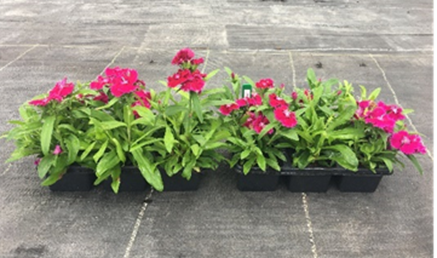
Dianthus (left to right): (a). water, (b). Pirouette plug spray 0.45 L/ha and Pirouette 0.45 L/ha (x2) post-transplant.
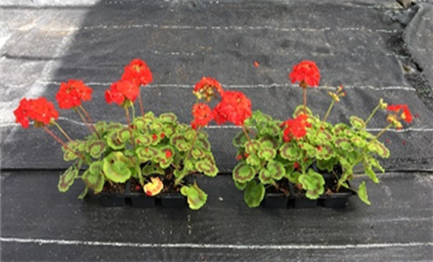
Pelargonium (left to right) (a). water, (b). Terpal plug spray 0.225 L/ha and Terpal 0.5 L/ha + Stena 0.75 L/ha post-transplant.
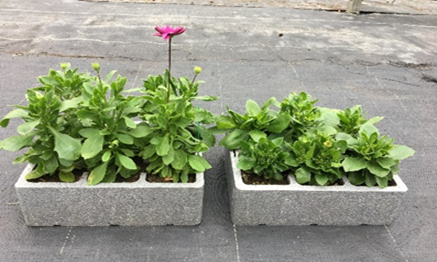
Osteospermum (left to right) (a). water, (b). Regalis plug spray 1.25 kg/ha and Canopy 0.337 kg/ha + Stena 0.75 L/ha followed by Regalis 1.25 kg/ha post-transplant.
Other notes in this series:
Forcing herbaceous perennials for early spring sales
Management of bought-in cutting material to retain quality
New plant growth regulators for use on poinsettia
The use of spectral filter polythene in bedding plant production
The use of spectral filter glass coatings in the production of protected ornamentals
Have a question? Ask the team ...

Sectors:

